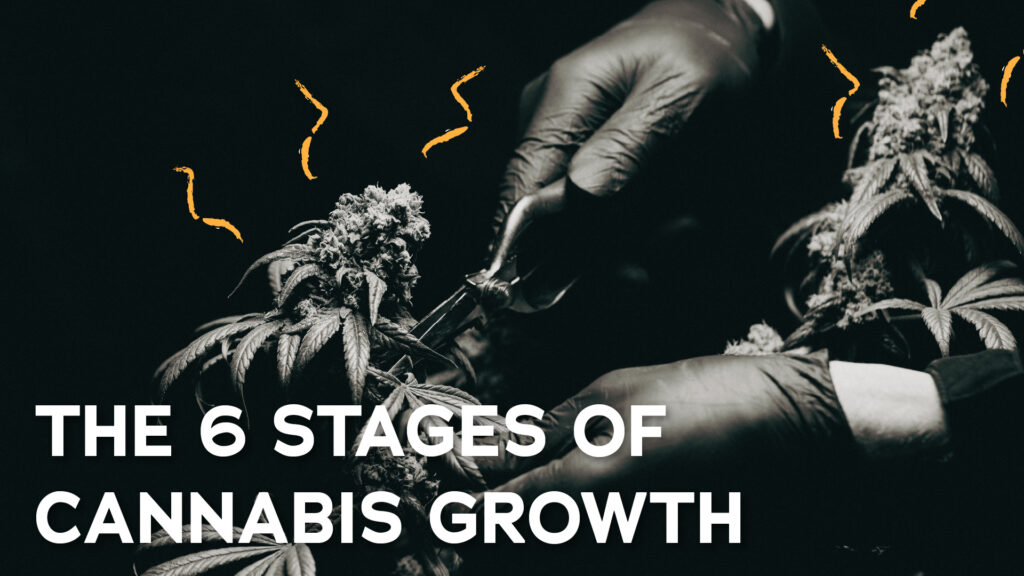Cannabis grows are just like farms, and the plants have their own stages and needs at every stage in order to produce the gorgeous, sticky buds we all know and love. But growing isn’t as simple as watering and getting the plants plenty of light. Cannabis has unique needs in order to flourish, and those needs can vary between cultivars.
In this post, we’ll explain the 6 stages of cannabis growth, what happens during each stage, and how different elements of the growing process are key to producing incredible buds!
Prologue: Seed Storage
So, this isn’t technically step one, but it is a key part of any reputable grower’s process.
Cannabis growers usually have a few cultivars that they are really proud of or that produce super high yields. Protecting these cultivars is essential for the longevity of the grow. In case of events like pest issues, power outages, feeding issues, or other problems that can compromise the health of a grow, cultivators keep seeds of their genetics stored for safekeeping.
This allows them to quickly bounce back from any issues with their crops and keep their super-star cultivars running strong!
Different growers use different methods to store their seeds, but seed storage keeps them dormant and ready for the first stage of growing whenever needed.
Stage 1: Germination
Germination is the starting point of the cannabis lifecycle. This stage starts with the seeds themselves and is exactly the same as how seeds from other plants germinate to begin growth.
What Germination Looks Like
Germination typically occurs in the first week or so of the plant’s life. The seeds will start as just seeds, then slowly begin to grow sprouts and roots and eventually their first few sets of leaves.
How Germination Happens
Cannabis seeds are naturally dormant when they are first gathered. This is a natural response that prevents them from sprouting too early as if the plant were growing outside – it prevents the seeds from spouting in harsh, colder weather.
To combat this, the seeds are usually stored before planting to allow for the dormancy period to pass. Then, the seeds are subjected to warmth, water, and oxygen to start the germination process. Over the course of a few days or about a week, the seeds will slowly sprout their first roots in these conditions.
Some growers will soak their seeds in a hydrogen peroxide solution for a few hours to break down their outer shell and encourage them to sprout quickly.
Stage 2: Seedling
In this stage, the cannabis plants will start to grow their first sets of leaves that will turn into the resulting plant. They aren’t quite ready to meet any potting medium, but they are well on their way!
What Seedlings Look Like
Seedlings are the in-between stage of a growing plant and the seed itself. The plant is still too small and immature to hold up in a potting medium, but they are rapidly growing. Seedlings usually sprout rounded, small leaves that don’t quite look like cannabis just yet.
What Happens in the Seedling Stage
Once the seedlings reach proper size and maturity, they go through their first transplant into what are called plugs. These plugs help facilitate healthy root growth that the plants need to grow strong.
Seedlings usually spend about 2 weeks in plugs to grow strong roots. From there, the plants are usually transferred into a potting medium to be trained and will start to grow leaves more recognizable as cannabis. More leaves and branches will begin to grow as well as the plant continues to mature.
Stage 3: Vegetative Stage
The vegetative stage is like the teenage years for the plants. This point is crucial in determining how well a harvest will develop and yield in the end, and growth occurs quickly from this point.
What the Vegetative Stage Looks Like
Plants enter the vegetative stage once they have an established root system and plenty of nodes producing stems and new leaves. Most growers will keep vegetative plants in larger pots for a few weeks before transferring them to their final growing vessels. Vegetative cannabis grows rapidly and roots very quickly.
What Happens in the Vegetative Stage
Vegetative plants are exposed to plenty of light and nutrients during this time to encourage rapid, healthy growth. Leaves expand to take in as much light as possible, and the plant focuses on growing as much as possible before flowering.
Cultivators will trim back or prune these plants to remove lower branches that are growing in the shade of the rest of the plant. This can increase the yield of the plant later on, as it focuses on growing the well-lit leaves toward the top of the plant rather than diverting energy and nutrients to the leaves below.
Pruning also promotes airflow throughout the grow area when you have a lot of plants in one space. It is also a powerful tool for pest management as it makes it easier for pest control products to evenly coat the plants.
Stage 4: Pre-Flowering
In the pre-flowering stage, the plants are gearing up to flower and may start to show distinct characteristics of their cultivar. This stage also indicates whether plants are male or female. This is crucial, as male plants cannot flower and must be removed from the grow area so that cultivators have total control over pollination. Some growers only grow female plants that have been bred to produce only female plants and seeds (feminized seeds).
What the Pre-Flowering Stage Looks Like
Pre-flowing plants are beginning to grow the reproductive parts needed to produce flowers. They are considered developmentally natural around 14-20 inches in height and should have about 10 nodes of growth by this point.
What Happens in the Pre-Flowering Stage
The biggest goal of this stage is to identify male versus female plants if the grower has not grown a female-only cultivar using feminized seeds. Some cultivators will send their plants to testing labs during the seedling phase to determine the plant sex, which can be helpful if the plants aren’t showing signs of their sex in pre-flowering.
Stage 5: Flowering
Flowering is exactly what it sounds like. The plants are reaching full maturity and being to form clusters of buds around the nodes and tips of the branches. This is also when the trichomes will begin to appear, and the plant will have the distinct characteristics of their cultivars such as colors and smells.
What the Flowering Stage Looks Like
Essentially, plants in the flowering stage begin to look like what you picture as a cannabis plant, which thick, stick buds and full leaves. Trichomes will develop on the buds making them appear sticky and fuzzy.
What Happens in the Flowering Stage
In this stage, it takes careful timing and observation to know when the plants are ready to be harvested. They are carefully fed specific nutrients to ensure they produce maximum yield and are meticulously taken care of. Cultivators will keep a close eye on how the plants change in appearance during this time, determining the best time for harvest when the plants are at peak potency.
Stage 6: Harvesting
Once the buds are in full bloom, it’s time to harvest! Plants will be at peak maturity and potency at this point, with lots of trichomes and strong aroma. Correctly timing the harvest is crucial to getting the best quality out of a crop.
What the Harvesting Stage Looks Like
At Harvest, the plants will be at their largest and will be at their most mature. The buds will develop into dense, sticky flowers that are saturated with trichomes. The plants will also be very aromatic and the trichomes will usually go from clear in appearance to slightly cloudy or darker than when they initially began to appear.
What Happens in the Harvesting Stage
Once perfect timing for harvest is determined, cultivators will cut down the plant and prepare it for drying and curing. Depending on what the buds will be used for, their process after harvest differs. Live products like live concentrates are usually fresh-frozen immediately after harvest to preserve the terpenes and cannabinoids in the plant for extraction. Regular dried flower and some concentrates are made from flower that is dried and cured.
Drying usually takes 1-2 weeks with the plants hung upside down in a cool, dark rooms with specific humidity. Curing is optional depending on the product the flower will be turned into and essentially the process of aging cannabis in temperature-controlled sealed containers.
Stages of Cannabis Growth - Conclusion
Cannabis goes through a remarkable life cycle in the grow. From just a small seedling to a large, potent plant, cultivators put a lot of love into the plants they grow. Every stage in this process is crucial to the growth of healthy, quality cannabis for flower, concentrates, edibles, and beyond.
We hope this post helped you learn more about the stages of cannabis growth! If you have any questions, let us know on our contact page. Shop our entire selection by store online, check out our Dreamz Dispensary storefront locations, and see our other blog posts for more information about cannabis and our products.





